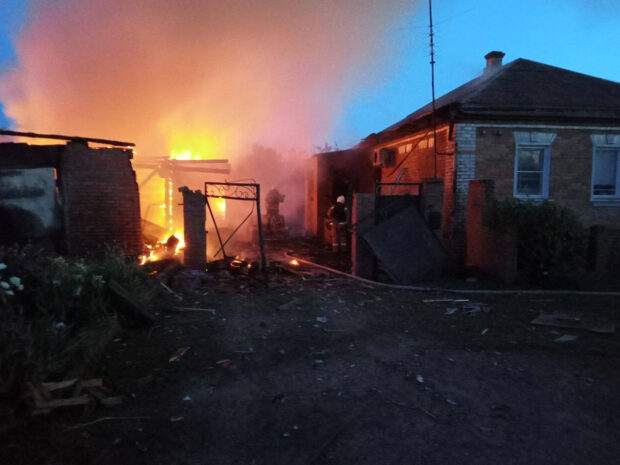Fighting rages on in south Ukraine as Putin dismisses offensive

Firefighters work at a house on fire following a shelling, which, according to the regional governor, was by Ukrainian forces, in the village of Sobolevka, Belgorod region, Russia, in this handout image released June 2, 2023. Governor of Russia’s Belgorod Region Vyacheslav Gladkov via Telegram/Handout via REUTERS
Kyiv, Ukraine — Fighting raged Friday in southern Ukraine, but Russian leader Vladimir Putin claimed Kyiv’s long-expected offensive was already failing.
Ukrainian President Volodymyr Zelensky praised the heroism of his country’s soldiers, but made no direct reference to what some observers believe is the start of Ukraine’s bid to claw back territory from Russia.
“For our soldiers, for all those who are in particularly tough battles these days, we see your heroism, and we are grateful to you for every minute of your life,” Zelensky said in his daily address.
Ukrainian officials have said their forces are ready, but there would be no formal announcement when the counter-offensive starts.
Earlier, Russian President Vladimir Putin said it had already begun, after Moscow said it had repelled several Ukrainian assaults.
“All counter-offensive efforts so far have failed, but the offensive potential of the Kyiv regime still remains,” Putin said in a video, as Washington announced a new $2.1-billion package of military aid for Ukraine.
Moscow says clashes have intensified since Thursday in the Zaporizhzhia region, home to Europe’s largest nuclear power plant, which relies on the waters of the Dnipro for its cooling ponds.
These water supplies have been put at risk by the destruction of the Kakhovka dam, which has left 600 square kilometres under water in the region, with around a dozen killed and thousands forced to flee.
New US aid
A Ukrainian military success in the Zaporizhzhia region would enable its forces to break through the land bridge that connects Russia with the Crimean peninsula it annexed from Ukraine.
That would be a major reversal for Moscow.
The Russian army has in recent months strengthened its front lines in the region, digging kilometres of trenches and fortifying defences.
The Russian army said it had repelled four attacks in the region, “carried out by forces of up to two battalion tactical groups, reinforced with tanks.”
The increase of fighting in the south has been seen by many observers as a sign that the counter-offensive is already happening, or is about to start.
Kyiv, however, said the main centre of combat was still in eastern Ukraine, while providing few details on the situation in the south.
Kyiv’s forces were bolstered with news of the new United States aid package, which will include missiles for Patriot air defence systems, artillery rounds, drones and laser-guided rocket system munitions.
The White House said on Friday Russia was receiving materials from Iran to build a drone factory on its territory that “could be fully operational early next year.”
Washington estimates that Russia has received hundreds of attack drones as well as related equipment from Iran to aid its war on Ukraine.
Dam breach casualties
Emergency services were racing to rescue people stranded by the flood-swollen waters of the Dnipro.
Russian-installed authorities in southern Ukraine on Friday reported eight deaths and said the water could keep rising.
The water, which flooded 22,273 homes in 17 settlements, could “keep rising for up to 10 days,” the Moscow-installed head of the Kherson region, Vladimir Saldo, said on Telegram.
However, officials in the Kherson and Mykolaiv regions reported that water levels had begun to recede there.
Ukrainian Interior Minister Igor Klymenko said at least five people had died and 13 were missing.
Explosives breached dam
Ukraine and Russia have traded blame for the destruction of the Kakhovka dam, but European Union foreign policy chief Josep Borrell said “everything indicates” Moscow was behind the breach.
“The dam was not bombed,” Borrell told Spanish public television. “It was destroyed by explosives installed in the areas where the turbines are located. This area is under Russian control.”
Norway’s seismological institute said it had detected “an explosion” at the site and time the dam was destroyed, supporting suggestions the breach did not occur as a result of damage incurred during months of heavy bombing.
Ukrhydroenergo, the dam’s operator, said it was most likely mined from the inside.
Ukrainian authorities said water levels in a reservoir created by the Kakhovka dam had fallen “below the critical point of 12.7 metres (42 feet)”.
They said the reservoir was no longer able to supply households and the cooling ponds at the huge Zaporizhzhia nuclear power plant.
However late on Thursday the International Atomic Energy Agency (IAEA) said the nuclear plant was continuing to receive water from the reservoir after the dam was damaged.
The plant’s six reactors have been shut down but they still need cooling water to ensure there is no nuclear disaster.
RELATED STORY:
Ukraine war comes to Moscow as both capitals hit by drones














